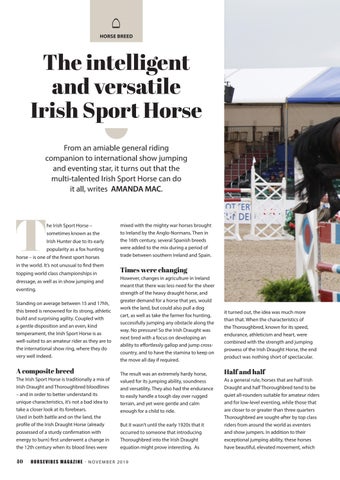HORSE BREED
The intelligent and versatile Irish Sport Horse From an amiable general riding companion to international show jumping and eventing star, it turns out that the multi-talented Irish Sport Horse can do it all, writes AMANDA MAC.
T
he Irish Sport Horse – sometimes known as the Irish Hunter due to its early popularity as a fox hunting
horse – is one of the finest sport horses in the world. It’s not unusual to find them topping world class championships in dressage, as well as in show jumping and eventing. Standing on average between 15 and 17hh, this breed is renowned for its strong, athletic build and surprising agility. Coupled with a gentle disposition and an even, kind temperament, the Irish Sport Horse is as well-suited to an amateur rider as they are to the international show ring, where they do very well indeed.
A composite breed The Irish Sport Horse is traditionally a mix of Irish Draught and Thoroughbred bloodlines – and in order to better understand its unique characteristics, it’s not a bad idea to take a closer look at its forebears. Used in both battle and on the land, the profile of the Irish Draught Horse (already possessed of a sturdy confirmation with energy to burn) first underwent a change in the 12th century when its blood lines were 40
mixed with the mighty war horses brought to Ireland by the Anglo-Normans. Then in the 16th century, several Spanish breeds were added to the mix during a period of trade between southern Ireland and Spain.
Times were changing However, changes in agriculture in Ireland meant that there was less need for the sheer strength of the heavy draught horse, and greater demand for a horse that yes, would work the land, but could also pull a dog cart, as well as take the farmer fox hunting, successfully jumping any obstacle along the way. No pressure! So the Irish Draught was next bred with a focus on developing an ability to effortlessly gallop and jump crosscountry, and to have the stamina to keep on the move all day if required. The result was an extremely hardy horse, valued for its jumping ability, soundness and versatility. They also had the endurance to easily handle a tough day over rugged terrain, and yet were gentle and calm enough for a child to ride. But it wasn’t until the early 1920s that it occurred to someone that introducing Thoroughbred into the Irish Draught equation might prove interesting. As
HORSEVIBES MAGAZINE - NOVEMBER 2019
it turned out, the idea was much more than that. When the characteristics of the Thoroughbred, known for its speed, endurance, athleticism and heart, were combined with the strength and jumping prowess of the Irish Draught Horse, the end product was nothing short of spectacular.
Half and half As a general rule, horses that are half Irish Draught and half Thoroughbred tend to be quiet all-rounders suitable for amateur riders and for low-level eventing, while those that are closer to or greater than three quarters Thoroughbred are sought-after by top class riders from around the world as eventers and show jumpers. In addition to their exceptional jumping ability, these horses have beautiful, elevated movement, which




















